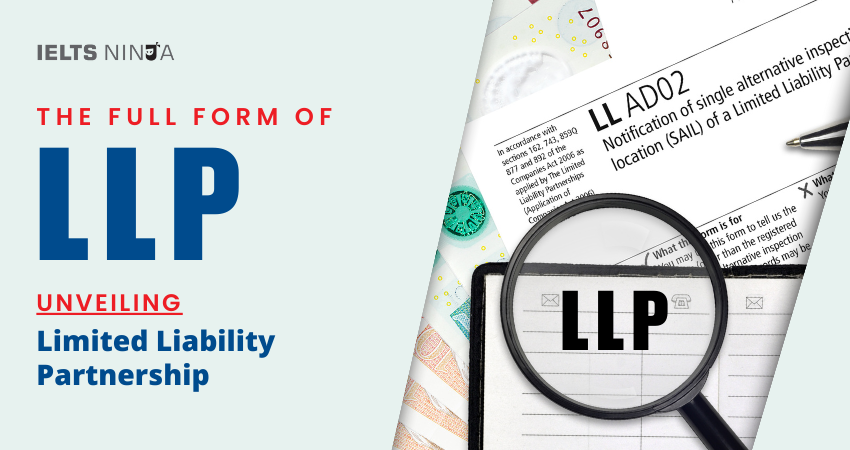The full form of LLP के लिए खड़ा है “Limited Liability Partnership”, और यह है a legal structure that combines elements of both a partnership and a corporation. LLPs provide business owners with the benefits of limited liability protection while allowing for the flexibility of a partnership. In this guide, we will explore the details of LLP, its formation, advantages, and key features.
Key Details of Limited Liability Partnership (LLP):
Formation of LLP:
Partners: An LLP must have a minimum of two partners, and there is no upper limit on the number of partners. These partners can be individuals or legal entities, such as corporations or other LLPs.
Registration:
LLPs must be registered with the appropriate government authority. In many countries, this involves filing the necessary documents and paying the required fees.
Name:
The LLP must have a unique name that is not already registered by another business entity. The name usually ends with “Limited Liability Partnership” or its abbreviation, “LLP.”
Agreement:
Partners typically draft a partnership agreement outlining the rights, responsibilities, and profit-sharing arrangements among the partners. While not mandatory in all jurisdictions, an agreement is recommended for clarity.
Advantages of LLP:
- Limited Liability: Like a corporation, the personal assets of LLP partners are protected from the business’s debts and liabilities. Partners are only liable to the extent of their capital contribution.
- Flexibility: LLPs offer flexibility in management and decision-making, with partners having the freedom to structure the organization as they see fit.
- Tax Benefits: In many jurisdictions, LLPs enjoy pass-through taxation, where profits are only taxed at the individual partner level, avoiding double taxation at both the corporate and individual levels.
- Perpetual Succession: LLPs can continue to exist beyond the life of a partner, ensuring continuity even in the event of a partner’s departure or death.
- Ease of Compliance: LLPs typically have fewer regulatory requirements and administrative burdens compared to corporations, making them easier to manage.
- Professional Services: LLPs are commonly used by professionals like lawyers, accountants, architects, and consultants due to their liability protection and flexibility.
Key Features of LLP:
- Separate Legal Entity: An LLP is considered a separate legal entity from its partners, meaning it can enter into contracts, own assets, and sue or be sued in its own name.
- Limited Liability: Partners are not personally liable for the debts and obligations of the LLP. Their liability is limited to their capital contribution to the LLP.
- Management: Partners can manage the LLP directly, or they can appoint designated partners who have more significant managerial responsibilities.
- Profit Sharing: Profits and losses of the LLP are typically shared among partners according to the terms of the partnership agreement.
- Regulatory Compliance: LLPs are subject to compliance requirements, such as filing annual returns and maintaining accounting records, which vary by jurisdiction.
- Transferability: The ownership interest in an LLP can usually be transferred, subject to any restrictions outlined in the partnership agreement.
- Termination: An LLP can be dissolved voluntarily by its partners or involuntarily due to specific events outlined in the partnership agreement or legal provisions.
यह भी पढ़ें: सर्वश्रेष्ठ ऑनलाइन आईईएलटीएस कोचिंग एवं प्रशिक्षण अकादमी
Examples of LLP Usage:
- Professional Services: Many law firms, accounting firms, and consulting companies choose the LLP structure to protect partners from individual liability.
- Real Estate: Real estate developers often use LLPs to limit liability while pooling resources for property investments.
- Family Businesses: Family-owned businesses sometimes opt for LLPs to maintain family control while protecting individual assets.
- Startups: Some startups choose LLPs for their flexibility and simplified administrative requirements, particularly when they are still in the early stages of growth.
Comparison with Other Business Structures:
- LLP vs. General Partnership: The key difference is that in a general partnership, partners have unlimited personal liability for the partnership’s debts, whereas LLP partners have limited liability.
- LLP vs. Corporation: While corporations offer limited liability, they often involve more regulatory compliance and formalities compared to LLPs.
- LLP vs. Limited Partnership (LP): In an LP, there are two types of partners: general partners (with unlimited liability) and limited partners (with limited liability). In an LLP, all partners enjoy limited liability.
निष्कर्ष:
ए Limited Liability Partnership (LLP) is a business structure that combines limited liability protection with the flexibility of a partnership. It offers advantages such as liability protection, tax benefits, and ease of compliance, making it a popular choice for various professional services, family businesses, and startups. Understanding the specific requirements and regulations of LLPs in your jurisdiction is essential when considering this business structure.








